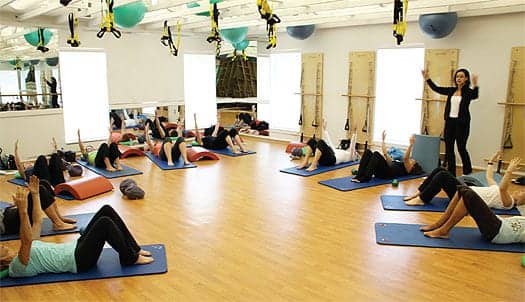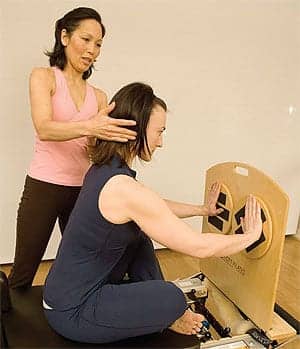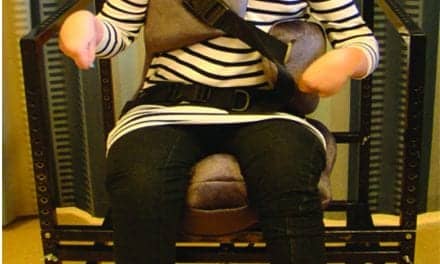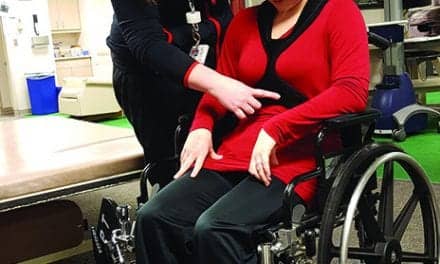PHOTOGRAPHY AT EQUILIBRIUM MIND-BODY FITNESS LLC

Kim Dunleavy, PT, PhD, MOMT, OCS
Pilates exercise programs are becoming increasingly available both as part of immediate physical therapy exercise alternatives and in post-rehabilitation environments. As one of the areas identified during the 2009 APTA Physical Therapy and Society Summit meeting was the potential for physical therapists to be more involved in overall fitness and wellness to match the needs of society, Pilates-based rehabilitation fitness is an ideal fit. The Pilates approach is historically linked with rehabilitation–Joseph Pilates developed the methods as a personal approach to overcome asthma and rickets using equipment available for post-polio rehabilitation. PTs are welcoming the opportunity to use their skills in exercise prescription, movement analysis, and teaching and apply them to the special fitness needs of the active aging population, sports enthusiasts, and individuals with biomechanical or inflammatory conditions and other medical diagnoses.
APPLYING THE APPROACH
Pilates principles and exercises have been modified using recent research in the rehabilitation field, and involve a biomechanical approach to develop muscular support around the spine, build muscular endurance and strength, and lengthen tight connective tissue. The Five Basic Principles involve the core position, and optimal postural alignment and biomechanical sequencing are key components of the exercises.1 The approach includes motor learning and control principles with feedback provided by instructors, and deliberate practice with conscious attention to body position and sequencing assisting with development of more efficient motor patterns.2
Pilates exercises can be used in the management of acute and chronic injuries. With decreasing insurance coverage, higher co-payments, and increased need for longer-term rehabilitation, Pilates is a valuable rehabilitation extension. The natural linkage from supervised exercise in the physical therapy clinic to community fitness is opening doors for physical therapists to practice in fitness and wellness environments. Rehabilitation Pilates instructors have the responsibility of establishing safe exercise programs tailored to clients’ unique requirements related to spinal or joint dysfunction, medical conditions, or postsurgical requirements. Clients often seek assistance from physical therapists after experiencing increased pain as a result of working out alone, without guidance/supervision, or in group classes. Clients with long-term chronic problems such as multiple sclerosis, inflammatory arthritis, or post-spinal surgery are also more comfortable with the supervision of a physical therapist, and they benefit from the supported positions and equipment available in the Pilates repertoire.

Kim Dunleavy, PT, teaching scapula stability principles during a STOTT PILATES® continuing education workshop on scoliosis managment at Equilibrium Pilates Studio in Bloomfield Hills, Mich.
My personal practice scenario is based out of an established Pilates training studio with a wide variety of clientele. My client base extends from teenagers with scoliosis and growth spurts to geriatric clients wanting to maintain an active lifestyle. I offer consultations for exercise program development, which may also include advice on what types of provisions are most suitable. Options such as group mat or reformer classes are popular as the expense is less; however, clients with more complex needs will generally benefit from individual instruction, until they learn and understand the basic exercises and are able to monitor their body position adequately. Clients with less-involved diagnoses may be suitable to work with certified Pilates instructors, while clients with chronic musculoskeletal dysfunction such as post-spinal surgery need to be monitored during individual sessions by physical therapists. Consultations are also a valuable option for fitness programs when clients develop pain as a result of a vigorous sporting session, a slip and fall, or other incidents, with appropriate advice if further medical evaluation is needed. If the client needs hands-on intensive physical therapy, we refer to other physical therapy providers in the area. Additionally, clients and staff members have the support and confidence of working with physical therapists in the studio and during prevention programs, which adds a vital component to the overall studio atmosphere.

For related articles, read “Fitting Pilates into a Rehabilitation Practice” and “Pilates: An Adjunct to a PT’s Practice” from previous issues.
CREATING A FITNESS REPERTOIRE
Some clients prefer the continuation of fitness programs with one person. Patient satisfaction is related to continued care and confidence in their providers,3 and once clients develop a trusted relationship, they are often hesitant to change instructors. Even in group classes, the continuation of care allows the fine-tuning and adjustment of exercises to efficiently provide an individualized approach while addressing the need for clients to work out in a cost-effective manner.
A Pilates-based fitness practice is possible using matwork exercises with the assistance of small props such as Flex-Bands®, Mini-Stability Balls™, barrels, larger exercise balls or Stability Balls™, Toning Balls™, and Fitness Circle® resistance rings, or it can involve larger equipment such as the Cadillac, Reformer, or Stability Chair™, which provides spring resistance or assistance to movement. Matwork exercises are useful for home programs and larger group classes, but in some cases they are more challenging for individuals with decreased core strength. The Cadillac, Reformer, and Chair provide alternatives for more or less supported exercises, and are very useful for individuals with mobility issues. Home care programs are possible with the equipment being available in space-efficient models. One of the key components is selecting exercises carefully, and modifying them for different postures, impairments, and goals. A progressive program is imperative to match the client’s improvement and meet their goals. The skills required for this type of function involve knowledge of biomechanics, an ability to analyze movement patterns, strong teaching skills, and additional training specific to the rehabilitation setting.
BUILDING A FITNESS CLIENTELE AND REACHING INTO THE COMMUNITY WITH A PILATES-BASED FITNESS PROGRAM
There are a number of methods involved in building a fitness clientele, including referrals from physicians and chiropractors. Web-based referrals are also increasingly important. Some physical therapy clinics offer group mat classes as an adjunct and transitional program for patients; however, Pilates studios are an ideal start point for a rehabilitation fitness practice. New clients, with a history of injuries or chronic pain, often choose to start with a Pilates rehabilitation instructor.
TYPE OF CLIENTELE WHO BENEFIT FROM PILATES-BASED PROGRAMS
There is a wide variety of clients seeking Pilates-based fitness programs; however, chronic musculoskeletal disorders–mechanical lumbar and cervical pain, osteoarthritis, and inflammatory arthritis–are a large subsection of the clientele.4,5 Biomechanical abnormalities such as scoliosis and postural disorders are also prevalent.6,7 I am working with a 15-year-old female whose initial kyphoscoliosis of 70° decreased progressively with rigid bracing combined with biweekly Pilates sessions; her curve has decreased to 24° over a course of 9 months. As her spinal position was corrected in the brace, she developed increased low thoracic pain followed by upper cervical pain. Pilates sessions allowed her to work on core strength and increase muscle length while she was adapting to the new positions and growth spurts.

Amy Slowik, PT, working with Martina Hauptmann, PT, on the STOTT PILATES® Reformer rotational discs at Equilibrium Studio in Bloomfield Hills, Mich, to challenge cervical and scapula stability while performing glenohumeral rotation. Hauptmann has a history of shoulder instability after a gymnastics injury.
The active aging clientele present with problems ranging from osteoporosis to fitness with joint replacements, balance, and neurological impairments. Pilates is now being recommended post-joint replacement as the number of physical therapy visits is often limited by insurance companies.8,9 There are a number of professionals who are continuing to work beyond the normal retirement age, including physicians, dentists, psychologists, and members of other professions where their job requires them to place consistent stress on their spine, for example, prolonged positioning. These individuals look for fitness programs to decrease stress and also to address chronic spinal pain.
There are also individuals who are looking to maintain general fitness while recovering from surgery or other medical treatment such as after breast cancer.10,11 I have worked with clients who want to maintain fitness and range of motion post-breast reconstruction and those preparing for surgery with optimum range, shoulder, and cervical support. These clients prefer one-on-one exercise supervision, which allows modification of the exercises based on their tolerance.
Clients often have more than one condition, therefore the ability to manage multiple areas with the same exercise benefits them enormously. There is also a growing interest in using Pilates for core conditioning for athletes, dancers, and performing artists. The physical therapists working with these groups must have the appropriate mix of preventive and rehabilitative exercises to offer their clients. Exercises are progressively more complex, based on a sound foundation of building the local muscular support around joints, followed by the recruitment of the larger global muscles. Higher-level exercises can use components essential for dancers, gymnasts, and skaters–the aesthetics of full range of motion, turnout, jumps, and coordinated sequences.12,13 Elite rhythmic gymnasts and dancers often have repeated injuries and return for fitness while recovering, along with addressing habitual movement patterns leading to repetitive-strain injuries.
FUTURE POSSIBILITIES
One of the advantages of fitness programs is the ability to follow clients beyond short-term recovery. Some unexpected observations have resulted from extended focus on alignment and biomechanical principles such as improvements in range of motion, vital capacity, and postural position in a client with ankylosing spondylitis. Another client with lumbar laminectomies and nerve compression had neurological return in his ankle dorsiflexors, evertors, and toe extensors 3 years after surgery. The expected prognosis of distal return was limited, but the continuation of exercise in a supported and aligned position allowed him to exercise without aggravating his condition. He is able to continue with an active surgical career along with cycling and skiing. This observation would not have been possible, if the client was not followed for 3 years.
PATIENT SATISFACTION
Patient satisfaction with the Pilates approach is high.14 The extended period of education and integration of biomechanical principles allows application into function and reinforces self-correction of movement, which further encourages fitness activities. In a survey of participants in post-rehabilitation Pilates for low back pain, participants stated that they were able to use the principles during walking, bending, lifting, and hobbies. They also credited the ability to return to swimming and walking programs, to control gained during Pilates sessions.14 The satisfaction is not just for the clients; there is enormous satisfaction from following clients through their total rehabilitation and developing long-standing relationships.
for related articles, visit www.rehabpub.com/. asp, and www.rehabpub.com/
REFERENCES
- Merrithew M. Pilates for pain management. Rehab Management. 2009;22(2):24,26-7.
- Lange C, Unnithan V, Larkam E, Latta P. Maximizing the benefits of Pilates-inspired exercise for learning functional motor skills. Journal of Bodywork and Movement Therapies. 2000;4(2):99-108.
- Beattie P, Dowda M, Turner C, Michener L, Nelson R. Longitudinal continuity of care is associated with high patient satisfaction with physical therapy. Phys Ther. 2005;85(10):1046-52.
- Maher CG. Effective physical treatment for chronic low back pain. Orthop Clin North Am. 2004;35(1):57-64.
- Rydeard R, Leger A, Smith D. Pilates-based therapeutic exercise: effect on subjects with nonspecific chronic low back pain and functional disability: a randomized controlled trial. J Orthop Sports Phys Ther. 2006;36(7):472-84.
- Lugo-Larcheveque N, Pescatello LS, Dugdale TW, Veltri DM, Roberts WO. Management of lower extremity malalignment during running with neuromuscular retraining of the proximal stabilizers. Curr Sports Med Rep. 2006;5(3):137-40.
- Zarzycka M, Rozek K, Zarzycka M. Alternative methods of conservative treatment of idiopathic scoliosis. Ortop Traumatol Rehabil. 2009;11(5):396-412.
- Levine B, Kaplanek B, Scafura D, Joffe WL. Rehabilitation after total hip and knee arthroplasty: a new regimen using Pilates training. Bull NYU Hosp Jt Dis. 2007;65(2):120-5.
- Levine B, Kaplanek B, Joffe WL. Pilates training for use in rehabilitation after total hip and knee arthroplasty: a preliminary report. Clin Orthop Relat Res. 2009;467(6):1468-75.
- Eyigor S, Karapolat H, Yesil H, Uslu R, Durmaz B. Effects of Pilates exercises on functional capacity, flexibility, fatigue, depression, and quality of life in female breast cancer patients: a randomized controlled study. Eur J Phys Rehabil Med. Epub May 6, 2010.
- Keays KS, Harris SR, Lucyshyn JM, MacIntyre DL. Effects of Pilates exercises on shoulder range of motion, pain, mood, and upper-extremity function in women living with breast cancer: a pilot study. Phys Ther. 2008;88(4):494-510.
- Khan K, Brown J, Way S, et al. Overuse injuries in classical ballet. Sports Med. 1995;19(5):341-57.
- Hutchinson MR, Tremain L, Christiansen J, Beitzel J. Improving leaping ability in elite rhythmic gymnasts. Med Sci Sports Exerc. 1998;30(10):1543-7.
- Dunleavy K, Giorgi L, et al. Patient satisfaction with Pilates based rehabilitation for the treatment of low back pain. APTA Combined Sections Meeting, New Orleans, 2011.
Kim Dunleavy, PT, PhD, MOMT, OCS, is a rehabilitation instructor at Equilibrium Studio, Bloomfield Hills, Mich. She has been using Pilates as part of her practice for 12 years and is a lead instructor trainer for STOTT PILATES® rehabilitation courses. Dunleavy is an assistant professor at Wayne State University Physical Therapy Program, Detroit. For more information, contact .




